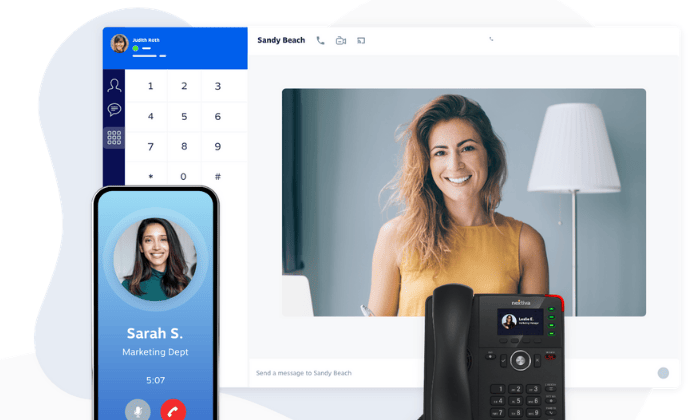Disclosure: This content is reader-supported, which means if you click on some of our links that we may earn a commission.
If you are frustrated with your current business phone system, it’s worth checking out your options.
You could save money, get a more useful set of features for your employees, and deliver a better experience for your customers.
But you want to be smart about shopping providers.
You can go anywhere on the web to find generic advice, like “choose a system that has the features you need.”
That helps nobody.
To help you play the field intelligently, my team reached out to experts who deploy business phone systems for a living and manage intense call centers.
Here, you’re going to find insights for buyers from a range of people that know what really matters. I talked with:
- Matt: A network engineer with more than 20 years of experience helping companies manage their IT.
- Nikhil: A founder of two cloud service companies and former managed service provider for unified communications.
- Lawrence: A network operations center engineer working for a cloud business phone system provider.
- Guy: A call center veteran with more than 15 years experience in keeping operations efficient.
- Terry: The head of IT for a midsize software company who has deployed and scaled contact centers for numerous use cases.
We talked in-depth about how the underlying technology gives companies a real-world edge they don’t have today, resulting in this buyers’ guide.
You don’t have to be an IT pro to benefit from hearing their perspective on what a “one-click” integration really means or how to keep a phone system from getting hacked.
Take a break from the run-of-the-mill guidance. Keep reading to find out which business phone systems are really delivering value and how to decide between the top options.
#1 – Nextiva Review — The Best for Remote Teams
Nextiva helped so many companies keep their operations running while offices were closed. It’s a safe, proven business phone system that works as well in an office as it does for on-the-go and work-from-home employees.
Since the platform is entirely cloud-based, it’s extremely easy to deploy. Get set up in minutes and every employee will have unlimited voice and video calling.
You can add texting for a few bucks a month or look into their contact center solutions if you want to unify communications with chat and email, as well. Whatever setup you choose, there’s no new equipment to buy and it’s effortless to upgrade if you want more channels or features down the road.
I like it for offices with remote workers because Nextiva isn’t a one-way street—it will work with landline phones if you need it to.
You have the flexibility for people to be in or out of the office without disrupting productivity or the customer experience.
New users will have hardly any trouble getting on board. They just download the Nextiva app and they can start making calls.
“It’s easier to just download the app and connect to the servers,” Nikhil explained about why both employees and administrators liked softphone apps. All the security is baked in, and your employees “can work from their mobile, tablet, or desktop without configuring as much.”
Keeping your phone system secure is a huge concern if you have remote workers signing in from home and public networks.
Lawrence told me you want a provider using TLS and SRTP to encrypt traffic so that no one “can see what you’re doing, or listen to any of the calls that go over that line.”
Nextiva uses both of these protocols to secure voice traffic, and also has fraud mitigation to detect and block suspicious calling activity on your account.
“A malicious actor can use your phone lines,” Lawrence said, “and you regularly see that there are multiple lines open to a faraway country with an expensive pay phone number.”
Nextiva constantly monitors your account for such toll fraud and other types of hacks, giving you peace of mind while workers are consistently outside your firewall.
There’s just a lot less to worry about with Nextiva providing your phone service. Your admins won’t have to provision specific phones or ensure that calls get to the right place. Because users are on softphones, that number follows them wherever they go.
This is important, as Matt noted, because it can get pretty tricky trying to route calls when people are moving around with a number tied to a specific phone.
Nextiva lets you avoid those headaches altogether. As long as someone is signed into their Nextiva account, all their preferences are stored and they’ll receive calls just fine.
In fact, Nextiva recently redeveloped their extension provisioning so that you can start a call flow from an extension:
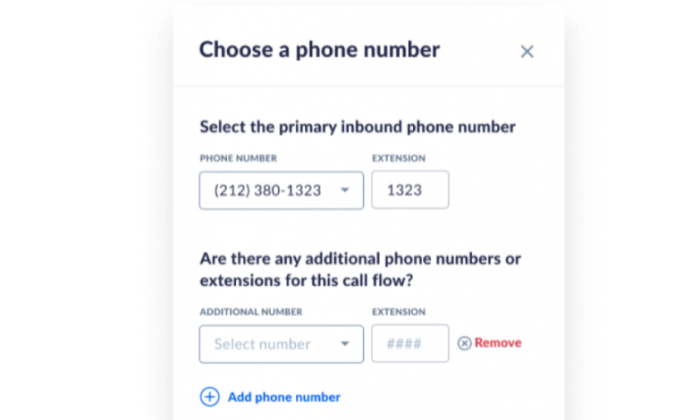
This lets you route internal calls without having to pay for extra numbers, which is sometimes unavoidable with other providers.
Plus, look how easy it is to add an extension—if you can order food online you can configure the Nextiva phone system.
This makes it easier to take advantage of the flexible routing features, like Find Me/Follow Me, and your employees can guarantee that calls find them no matter where they’re working that day.
As Matt explained, Follow Me features are a big step up from simple call forwarding.
“Sure, back in the day, you could forward calls to your cell, and you would get to answer,” he said, “but you wouldn’t see who it was.” Now that the feature is digital, “it’s just a lot more robust,”
Follow Me lets you set answering rules that redirect your call to multiple places—your office, your cell, your home—before sending someone to voicemail. You can even set rules based on what day or time of day it is.
“It guarantees that the person on the other end could possibly get you rather than just get your voicemail, which nobody listens to nowadays,” said Matt.
There are other features designed to make the lives of administrators and supervisors more manageable. The admin portal makes quick work of adding new users, and admins can edit active call flows. Switch up your phone menu, greetings, or reroute calls without shutting off your phone system to make changes.
Your supervisors have access to a rich set of team collaboration tools, including:
- Team calendar
- Screen sharing
- Persistent chat (team messaging)
- Multi-site support
- Real-time status alerts
- Video conferencing
Be it sales, service, or just general business needs, everyone benefits with team messaging and an auto attendant that gets calls to the right place faster.
Perhaps the chief reason companies opt for Nextiva is its highly available customer service. You can reach out by email, chat, or phone, 24 hours a day. This is very attractive, as phone support is usually something that only comes with other providers’ premium plans.
On-demand technical support is a boon to teams that aren’t always in the office. Additionally, Nextia offers superior guidance and training to help your team get the most out of your new system on day one.
Nextiva actually took home multiple Stevie awards in 2020, which recognized the company’s consistently high quality of service.
The company will also help you migrate your existing phone number to ensure that your entire system is working as planned. With all but the entry-level plan, Nextiva includes professional implementation as part of the price tag.
Let’s take a closer look at how to buy Nextiva, as the company supports a wide range of businesses with their flexible pricing pricing structure:
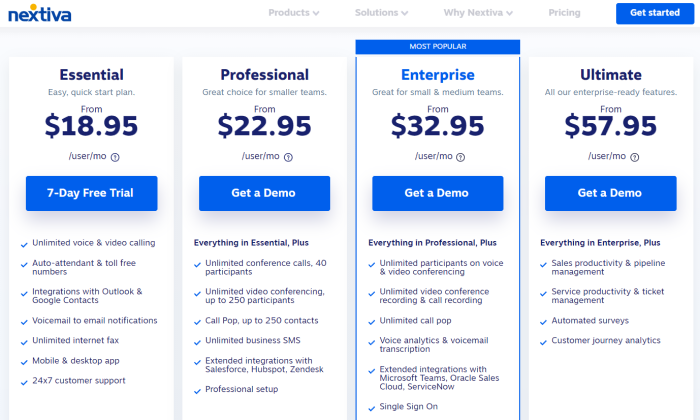
The above prices are for annual subscriptions. You can opt to pay a little more per month if you don’t want to sign up for a year.
Essential is one of the cheapest plans on the market that offers voice, video, text, and fax. If you are looking for an affordable business phone system that supports multiple channels and remote collaboration, this is it.
That said, the Essential plan lacks video conferencing and many of the integrations that make Nextiva such an easy option for remote work. You get integrations with Outlook and Google Contacts, but you have to upgrade to Professional in order to tie in CRM software like HubSpot, Zendesk, and Salesforce.
The other major perk of upgrading to Professional that makes a lot of sense for remote teams is that you get full 24/7 customer support. With Essential, you are limited to support during business hours.
For companies that don’t have a CRM already, Nextiva includes one for free at the Professional tier, which is only marginally more expensive than Essential.
The Nextos CRM, which is built right into the platform, has special applications for both sales and service. It’s native, so you don’t have to spend time getting the apps to talk to one another.
This is very appealing, because you get the CRM functionality without having to pay for an additional service, or “jump through hoops” trying to make the integration work, which Jason said can be pretty challenging.
He also highlighted difficulties getting multiple CRMs to work on the same network for different departments. Say your sales team is using Sugar CRM and your service team is using Zendesk. Nextiva has integrations with both of those applications, so you have a lot less to configure on your own.
Enterprise and Ultimate tiers include a longer list of integrations, richer analytics and survey tools, and a deeper set of features with the Nextos CRM platform.
I want to call out the Enterprise plan, which starts at $32.95/month per user, as being extremely affordable compared to similarly feature-rich plans from other providers.
In short, Nextiva is a full-bodied business phone solution that delivers top-quality communications for businesses of any size. In the office, out of the office, it doesn’t matter. Nextiva has you covered.
You can try the Essentials plan free for seven days or request a demo of a premium plan.
#2 – RingCentral Review — The Best for Integrating Phones With Your Business
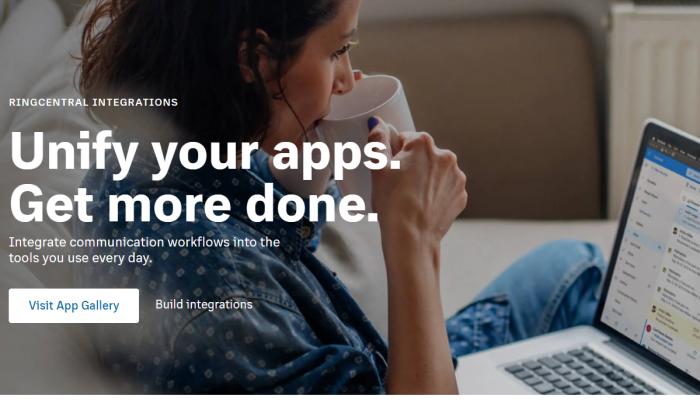
RingCentral has become one of the most popular service providers in the business communications space. They offer every feature a growing business needs at a competitive price. Unlimited calling, texting, and video don’t hurt either.
It’s my top pick for businesses that want to integrate their existing business software with their new phone system.
It doesn’t offer a built-in CRM like Nextiva, but it has pre-built integrations with a much longer list of apps. Most users will be able to keep using the software that has helped them get to the point where they are now—you don’t have to reinvent the wheel.
And because RingCentral is so widely used, all of these integrations have been tried, tested, and improved under a range of conditions.
This is really important—not all integrations are equal. As Terry pointed out, some integrations involve a lot of development work on your end, to actually get “the systems to communicate with each other the way you want.”
RingCentral has taken as much of that work off your plate as possible. There’s still going to be some initial setup, especially if you’ve customized your CRM or ERP to the nth degree already. But you’ll quickly find out why so many users describe the integration process as seamless, and ample documentation online should you encounter issues along the way.
And the benefits in terms of streamlining the workday for your employees are hard to overstate.With Salesforce integration, for example, you can click-to-dial contacts, schedule video meetings, connect the phones to your sales cadence—all within your Salesforce account.
Think of how much time this saves for every call.
Plus, you’re going to be able to track metrics that really matter. With the CRM integration, your analytics are going to reflect information about your customers, not just call times.
You can get really crafty with the segmentation to look at sales goals in different buyer brackets, geographies, or whatever you think is worth tracking.
That’s just one example, but RingCentral offers far more pre-built integrations than any other platform I reviewed.

You want to be able to share information throughout the company, and it really grates on employees when they have to manually move data between apps that don’t play well together.
From my experience and from talking with experts, I recommend demoing these products, if not reaching out to RingCentral to get a reference from a similarly situated customer. This will give you the best possible sense of the quality and depth of each pre-built integration.
But when you’re thinking about connecting your other software, integration is only one part of building out a more efficient process for your teams. RingCentral gives you an extensive range of call handling and administrative features, which will let you tune your system perfectly for each part of your company.
As Terry explained, customer service CRMs tend to be “a little more complicated from a phone system standpoint” than those for sales.
Why? Because sales is generally about getting incoming calls to people as quickly as possible. In a support situation, “it’s not the opposite, but it’s kind of close,” he said with a little bit of a laugh.
Terry’s not arguing for service teams to give customers the runaround, but you do need to make sure that the person calling actually has a problem. From there, you want to direct them to self-service resources first.
Maybe they can reset their password without speaking to an agent, for example. Both parties are going to be happy about that outcome. This keeps your lines clear and lets your service agents focus on customers with really thorny issues.
RingCentral provides everything you need to manage call queues and set up your phone tree to direct customers however you need.
Integrate your phone system with live chat software and have bots provide automated responses that allow customers to answer a question on their own. Or let the bot triage incoming chats and gather info for when a rep takes over. Incorporate that with skills-based routing that gets a Spanish-speaking caller to the appropriate agent.
There are a ton of opportunities to streamline workflows and improve the overall customer experience because RingCentral is so easy to connect to the other parts of your business.
Some of the platform’s other highlight features include:
- Single sign-on
- Visual voicemail and voicemail to text
- Team messaging
- Real-time analytics
- Developer platform
- Quality of service reports
RingCentral is cloud-based and hosted, so your agents are going to be able to work from the office and home without much of a hiccup. It’s secure, dependable, and well within the price range for many businesses.
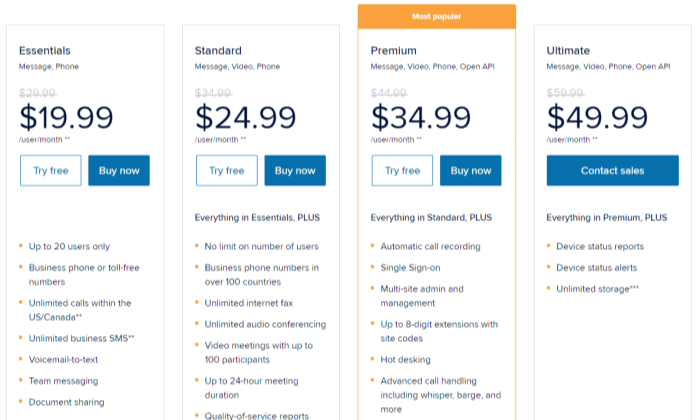
The entry-level Essentials tier is capped at 20 users and comes at a fairly attractive price for very small businesses. But I want to focus on the other plans, which include integrations with the popular software I’ve been describing.
Standard comes with unlimited voice, video, text, and online fax, as well as essential administrative features to stay organized. At this tier, you get integration with productivity suites, like Microsoft 365, Google Workspace, as well as collaboration software, analytics tools, bots, and more.
Premium includes multi-site administration and management, as well as a multi-level auto attendant to route calls more effectively across sites. You also get advanced in-call features and CRM integrations to help sales, customer service, and general customer success.
Premium is still a very competitive price, and the CRM integration is well worth it. You’ll also get access to industry-specific integrations for healthcare, manufacturing, and other verticals. It’s really worth digging into their extensive App gallery to see what’s available.
The Ultimate tier comes with unlimited automatic call recording, which is a boon for organizations with compliance concerns or potential legal exposure. It also includes device and status alerts to assist admins and supervisors with monitoring critical KPIs at scale.
At the end of the day, companies love RingCentral because it can be molded to suit the way you do business. It makes everyone’s workday a little more streamlined, every interaction a little more productive.
Try out RingCentral free for 15 days and get access to Essentials, Standard, or Premium. Test the phone system, integrations, and discover why so many businesses choose RingCentral.
#3 – Ooma Review — The Best for Companies That Want Deskphones
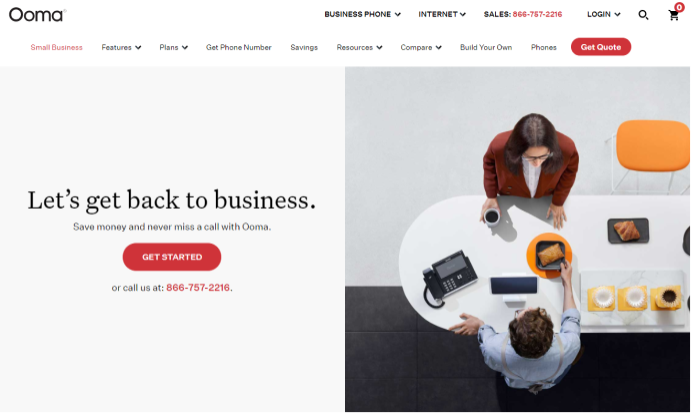
Want to keep all the things you like about traditional phones and get rid of all the annoying parts? That is Ooma Office, my number one choice for people who want the hardware without the headaches.
Use your analog phones, mobile phones, computers, laptops, conference phones, fax machines—whatever you have—and Ooma will work beautifully.
The Ooma softphone app can be used as soon as you sign up. If you choose to order desk phones through Ooma or use the ones you already have, the entire activation and setup process takes about 15 minutes.
By purchasing phones directly from Ooma, they’ll come preconfigured. As soon as you plug it in, the phone will automatically establish a secure connection with Ooma and you can start dialing.
The company actually uses the same technology governments use to encrypt classified data, including a VPN tunnel and SRTP. This is exactly the type of security that Lawrence and Matt told our team to look for.
Go ahead, ditch the old PBX and discover how easy Ooma makes it to personalize your phone system. You get full control over configuration through the Ooma Office web portal.
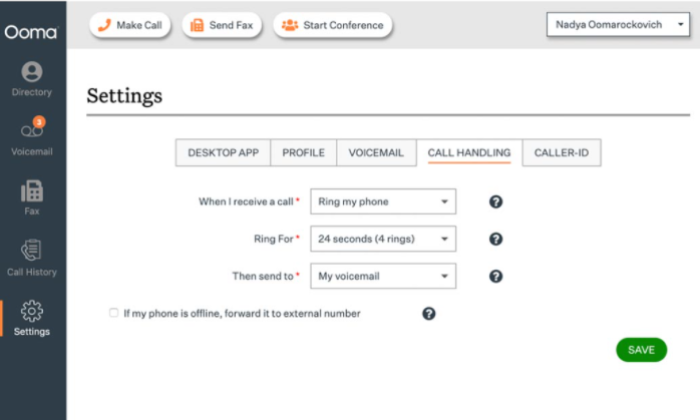
It’s not as sleek as Nextiva, but it’s very clean and straight-forward. Most people who switch from a traditional PBX wind up being able to do way more themselves at a fraction of the cost.
You no longer have to know anything about how the underlying technology works in order to set up a virtual receptionist to greet callers and route them to the appropriate department. You can opt for all phones to ring in the department, or have them ring in a particular sequence if your primary contact can’t answer.
Creating a ring group like this used to be difficult, but it’s just a few clicks in Ooma.
The same goes for hot desking, which allows Ooma Enterprise users to make calls from any phone. Lawrence described how his company—which doesn’t have fixed workspaces for individual employees—really benefited from the ability for employees to go up to any phone in the office, enter their extension, and start making calls.
“Even if you have multiple branches and you work from a different branch,” said Lawrence, “you can just go there, and know that the phone system will work.” Any one of your employees can use any phone and once they connect, all of their preferences and settings will be right there.
One reason I really like Ooma for small business is that you don’t need to sign a contract to get the best deal. They will port one number per line for free and there are zero hidden charges.
So that’s transparent pricing, no contracts, and access to a robust business phone system with features like:
- A conference bridge for each user
- Call management tools
- SMS messaging
- Ring groups
- Extensions, and extension-to-extension dialing
- Intercom
And that’s not even the full list of what’s included with Ooma Office, which starts at $19.95/month per line.
Like the other providers I looked at, you’ll get unlimited calling in the US and Canada, but Ooma’s unlimited coverage extends to Mexico and Puerto Rico as well.
The company also has lower than average international calling rates. For example, a call to China would be 2¢ per minute with Ooma Office, whereas the same call would be 3¢ per minute with Dialpad or 3.9¢ with RingCentral.
That 1-2¢ savings adds up quickly if you have a lot of customers abroad.
As I mentioned, the pricing is extremely straightforward.
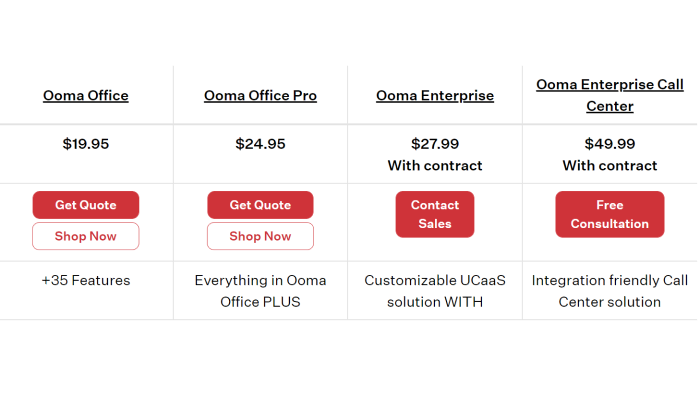
If you choose to upgrade to Office Pro, you get video conferencing, call recording, voicemail transcription, and access to the Ooma desktop app.
Ooma Office is going to be more than enough for many businesses, unless of course they absolutely require one of the key features that come with Ooma Office Pro.
The price of upgrading is very reasonable, and well below the price of other companies that offer a similar range of services.
Ooma Enterprise (which does require a contract) gives you access to more channels. But it’s not quite as turnkey as other unified communications platforms, like you can get through RingCentral, Nextiva, and Dialpad.
I say this because a lot of the integration and functionality that comes baked in with those platforms has to be done custom with Ooma Enterprise.
This could provide a better end result for companies struggling to fit their workflows into pre-built integrations from those other providers.. Ooma has worked with restaurants and retail to streamline order tracking, payments, and reporting through integration.
As much as I like the pre-built integrations, there’s a “cookie cutter” aspect that comes from trying to make them work generally. So it’s worth giving Ooma a call if you aren’t wowed by the integrations offered by other platforms.
Enterprise subscriptions also come with a greater range of features, like hot desking, advanced call flows, and team messaging. The Enterprise Call Center solution is billed as a complete UCaaS, but neither I nor the experts we talked with had any experience with it, so you’ll have to investigate yourself.
For small businesses, though, Ooma Office is a tried and true way to keep the phones working with minimal complexity. It’s a true plug-and-play solution that works with a wide variety of phones. Analog, IP, wireless, and conference phones are all going to work just fine.
Keep your equipment if you have it, or buy new phones at a price that often beats the local dealer. Ooma offers open standards phones from manufacturers like Yealink, a favorite among the experts, so you can mix new phones into your old system with minimal frustration.
Hang on to your existing number, pick a new one, set up a toll-free number, connect online fax—none of this takes any time at all.
Now you have a cloud-based phone system that unites all of your tools within a business phone system that works in the office or on-the-go.
If your current business phone system isn’t getting it done, give Ooma a try, risk-free, today.
#4 – Grasshopper Review — The Best for Businesses That Need Fewer than 10 Lines
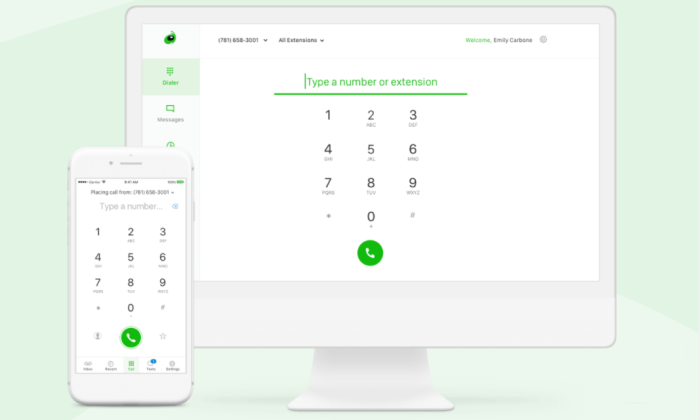
If you need a very simple phone system, Grasshopper can provide it for a lot less than some of the other options I’ve reviewed.
It’s not as deep in features as some of the more expensive packages from other providers, but small businesses get the essentials of a modern business phone system.
Plus, unlike other options, every Grasshopper plan comes with every feature the company offers—so you’re not having to purchase more than you need just to solve one particular issue.
The most basic plan comes with a business number that works on any device and three free extensions. Bear in mind that extensions aren’t always free, especially with budget-friendly options.
With Grasshopper, on the other hand, you can outfit a small team for the price of a single line.
It’s really a complete package for the small office. Scaling up remains affordable, though I wouldn’t push it too far over ten lines, as the call administration is really geared towards smaller business phone systems.
Grasshopper is a perfect low-cost, all-in solution for a single brick-and-mortar, a small warehouse, a company with a few different locations, or a toll-free number for an ecommerce site.
Grasshopper isn’t as elaborate, but that helps teams get comfortable with it more quickly. You don’t have to have an IT wizard on staff in order to add a new user or extension. Because of the simplicity, even your most tech-averse users are going to be fine managing business calls from their personal cell.
Nothing is going to be tied to a hard phone with Grasshopper, so you don’t have all the headaches Matt talked about with regards to people moving from station to station. There’s no backend provisioning necessary if personnel get shifted from one desk to another, which you’d have to do with deskphones in many cases.
Despite the flexibility, you still get the core phone system functionality small businesses need. Transfer calls and set extensions to forward calls to any device with a phone number. Send calls to a landline if you want.
You get the core phone features without the IT drama or security concerns. Some of the most useful for small business include:
- Business texting
- Call forwarding and transfers
- Virtual fax
- Voicemail transcription
- Free extensions
- Simultaneous call handling
- Call screening
- Custom greetings
For someone trying to run their business off a cell phone or struggling to manage an outdated phone system, Grasshopper is a revelation. Instantly, you’ll be able to screen calls and know whether it’s a personal or work call.
On your end, you’ll be able to choose which number you want to call from. No more carrying two phones or anxiety over which type of call you’re getting.
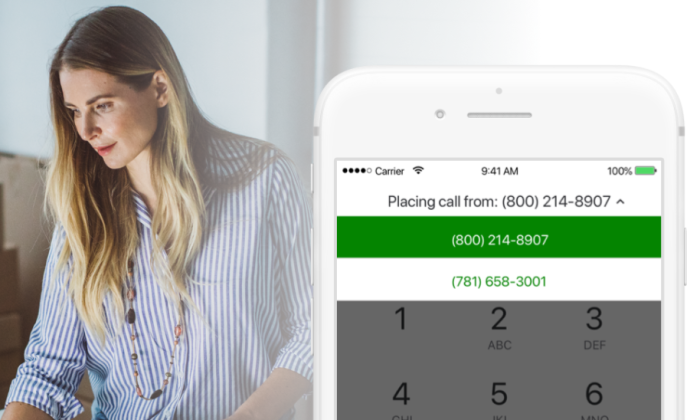
And when callers dial in, they’ll be welcomed by a professional greeting. Answer questions about business hours or let them select which department they’d like to speak with.
Because you get free extensions with every line you purchase, you’re not paying for dozens of extra numbers just to route calls.
One of the other features that I think is critical for small businesses today is texting. That’s included with Grasshopper, which makes the system a very cost-effective way to open additional channels of communication with your customers.
Set up instant responses to new callers when you’re on the line or in a meeting. Read a voicemail transcription, respond with a text, and you won’t even have to make a call.
Grasshopper plans include unlimited calling and texting. You’re looking at a flat rate each month. The prices below reflect an annual subscription, and are a few dollars higher if you choose to pay month-to-month.
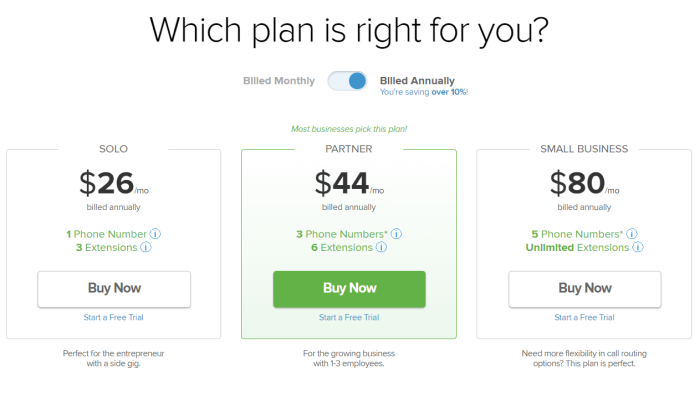
Since every feature comes with every plan, you’re really buying based on how many phone numbers and extensions you need. Solo comes with one number and three extensions, which can be routed to your cell, home, other colleagues, or different locations.
Partner comes with three numbers and six extensions, which is ideal if you’re trying to grow beyond a single location or manage teams in the field. Small Business comes with five numbers and unlimited extensions.
With Partner and Small Business, you won’t have to ask employees to give you their personal number or buy them a phone. They’ll be set up with everything they need to receive, screen, and transfer calls.
You can purchase extra numbers for $10 per month each or hire a Ruby Receptionist, which is a live US-based agent who can answer calls and speak with customers. It starts at $135 per month for 50 receptionist minutes, and the cost per minute goes down the more you purchase.
This could be huge for a small company that’s struggling to man the phones. For a tiny fraction of what it would cost to hire a full-time person, you can stop worrying about missing calls and know that it’s handled.
I really like Grasshopper for small business. It’s all the necessary parts of a phone system without tons of features aimed at call centers or larger businesses. You can’t get too fancy—there are no direct integrations with other platforms and there’s no easy way to add additional channels—but it excels at the essentials.
OpenPhone is similar, but people that are looking for a more traditional office phone experience will like Grasshopper because it handles things like virtual fax and extensions with forwarding rules.
If you want a stress-free business phone system for small businesses, you should try it out. Grasshopper offers a 7-day free trial, no credit card required.
#5 – Dialpad Review — The Only Way To Deploy A Contact Center in 10 Minutes
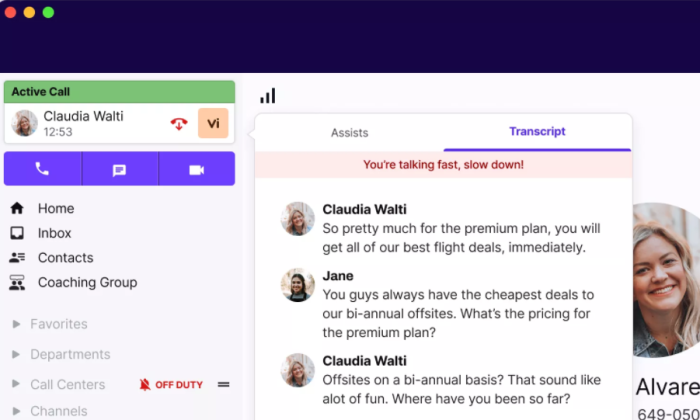
I like Dialpad because it takes the complication out of call center work for employees and delivers a great experience to customers. Everything about the platform is streamlined, clear, and made for the way communication happens today.
You can (and should) check out Dialpad for individual channels, but if you’re looking for an all-in contact center system that works out of the box, this is it.
“Nobody goes out of the way and says, ‘Hey, I can’t wait to call into this contact center,’” Guy told my team, drawing on years of first-hand experience. “However, when they are going to do it, you want to make it as seamless as possible.”
Dialpad gives you everything you need. Deploy in minutes and continually improve your system over time with Dialpad’s unique set of integrations, AI-powered analytics, and speech recognition technology.
These features deliver meaningful benefits to your agents during every interaction. If an unknown caller says their name, Dialpad will pin it to the call screen and apply it to the real-time transcript of the conversation.
Agents talk to dozens of people before lunch each day. Having names and a running transcript of what was said is going to make each conversation that much easier. Agents aren’t asking people to repeat information, and they can refer back to past conversations with the same client in a click or two.
Once the call is complete, Dialpad pulls action items out of the call for review. No more scribbling notes or logging into another platform to check boxes.
Agents can actually share these call highlights with coworkers or supervisors with a couple clicks, leaving a short note for context:
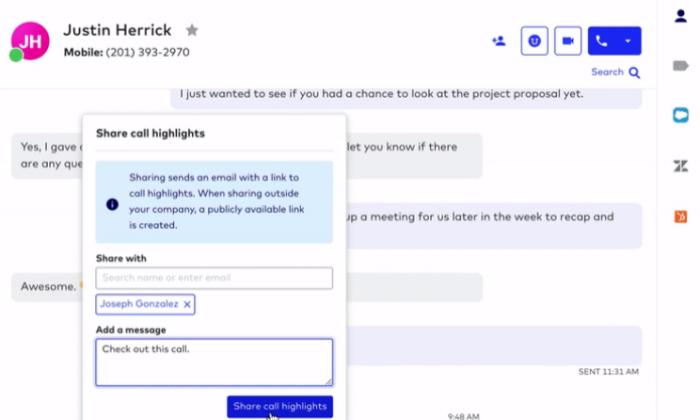
The entire experience seems like a step forward to me. From the agent perspective, everything is centralized, regardless of what channels they are using. The platform minimizes the number of clicks each action takes, which boosts productivity and resolves problems for customers faster.
When an agent clicks to record a call, for example, an automated message plays that says the call is being recorded. This is a big deal, because companies can face steep fines if they don’t let a caller know the conversation is being recorded. Such violations range from $500 – $2,500, or even jail time.
The laws vary in different states and countries, but agents don’t have to remember to say anything with Dialpad. It happens automatically.
You’re completely covered in terms of call routing and administration features. Get as crafty as you want standing up your call center, tie in every channel, integrate your business software, and Dialpad remains easy to manage.
Reviewing call recordings, for example, is much easier for supervisors when every conversation has been transcribed and time-stamped. Add that to the deep analytics features, and you have a phone system that allows team leaders to take action when they see an agent in trouble.
Guy was long on supervisor features that help train agents. In call centers, employee burnout is a reality. Yes, Guy said, people get tired of taking tons of calls, but another factor is that “agents don’t get a lot of very specific, detailed feedback about how they can improve.”
With Dialpad, there are so many opportunities to intervene. Supervisors can listen in to live calls, “whisper” to agents so the caller can’t hear, or “barge” in and take over the call. Alternatively, they could listen in and reach out through the chat app.
“If I’m able to monitor my agent live, and I can see that their handle time is really going past eight or nine minutes, I can drop in and listen in,” Guy said, “and maybe I can co-pilot and help land the plane.”
Another way to increase agent productivity (and happiness) is skills-based routing, which assigns calls to agents based on their areas of expertise. Guy said agents get overwhelmed when their supervisor just throws them on the phone and says, “You need to start knowing a lot about everything.”
You’ll also see that skills-based routing will increase your first call resolution because your agents that are specialized are automatically fielding calls in their area. It’s a real win-win, and you’re not purchasing any extra hardware or writing complex scripts to get this done.
It’s a really deep platform and you should absolutely investigate the whole of what it lets you do. But let’s quickly highlight some of the other standout features you get with Dialpad Call Center:
- Customer sentiment tracking
- Custom hold music
- In-queue callback
- Manager alerts
- Real-time agent recommendations
- Pre-built integrations with Salesforce, Zendesk, Kustomer and more
Dialpad acquired TalkIQ, a company that specialized in speech recognition and natural language processing. It’s just a cut above, and during conversations, Dialpad will pull from your knowledge-base to make real-time recommendations to agents.
For example, if a customer says they want to apply for a loan, all the relevant SOPs and documents pop right up on the agent’s screen. “Yes, I’d be happy to help with that,” a relatively new agent can say, confidently guiding the customer through each step of the process.
You’re going to have to get in touch with Dialpad to get a price for their call center solution, though there is a three-license minimum for the Pro plan and a 100-license minimum for the Enterprise plan.
Dialpad’s basic business communication service is about $5 less per month than both Nextiva and RingCentral. You still get unlimited talk and text, so this might be a good option even if you’re not just looking to use it for a contact center.
I’d take a hard look at Dialpad if you’re having trouble finding a solution that accommodates all the integrations and channels you want. The company has a rich app marketplace, as well as an open API and Zapier integration to connect virtually any tool teams use today.
Request a free trial of Dialpad contact center today.
#6 – OpenPhone Review — The Best for Single Teams and Sole Proprietors
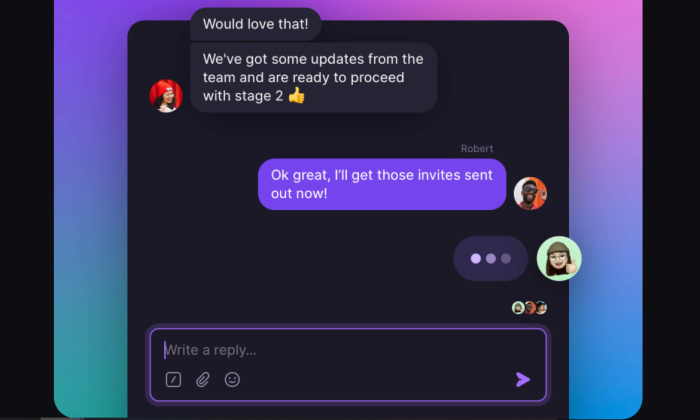
OpenPhone is designed with freelancers, founders, and entrepreneurs working alone or with small teams. It gives you a separate business number on your mobile phone, but unlike other apps that do the same thing, it has very few limitations.
When we’re talking about “second line” solutions like Google Voice, it’s handy, but primitive. You’re not giving incoming callers a menu of options or the ability to transfer calls. But with OpenPhone, you get both plus so much more.
Instantly, you can establish a professional business identity—no more handing out your personal number. People who call your number are greeted by an auto attendant that lets them press one for sales, or two to hear business hours. It’s easy to configure and a major step up in terms of how your business appears to prospective customers.
OpenPhone will get you a new local or toll-free number, and their team will help you port your old number over if you want to keep it.
Starting at $10 per month, OpenPhone is less than half the cost of other basic business phone systems. You’re not getting video conferencing, sure, but you have unlimited talk and text on any device.
If you have employees or partners, you can set them up with a business number for $5 per month. They’ll be able to use their own number, but you can also set up shared numbers and inboxes to keep everyone on the same page.
This is a big deal and where OpenPhone really stands apart from the competition. There are much more comprehensive (and expensive) phone systems that don’t let you do this.
With OpenPhone, you get threaded group messaging to communicate within the team, and the ability for multiple users to call and text from a single number.
As David Sacks, the investor from Craft Ventures who led OpenPhone’s most recent round of funding told VentureBeat, “OpenPhone puts the business phone inside a collaborative app that anyone on the team can use from wherever they are.”
For the busy entrepreneur or small business owner, the end result is that it’s much easier to communicate with people in and out of the organization. Everyone can see what’s happening, what needs to get done, and has the tools to respond immediately.
You’re not getting some watered down system with limited capabilities. Attach files and send SMS, MMS, or even GIFs:
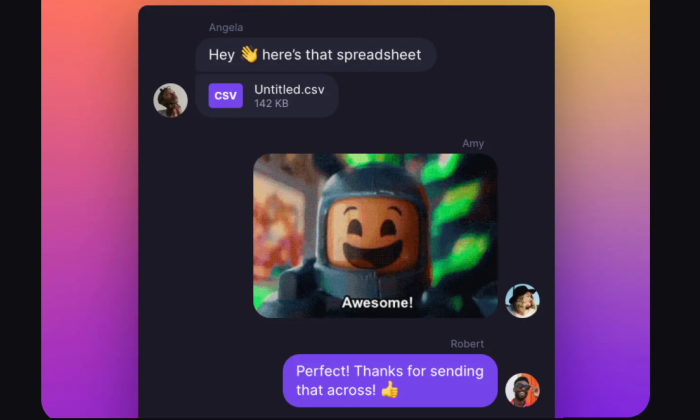
I feel like a lot of the budget-friendly business phone solutions leave a lot to be desired in terms of user experience, but not OpenPhone. Yes, it’s just the bare essentials, but the app’s not freighted by legacy phone technology in the slightest—it’s perfectly designed for small business communication in the 21st century.
As Guy pointed out, smaller companies benefit from having the ability to work on multiple channels. “You have to depend on more of your folks to do more things in the smaller desks,” he said. But it’s not enough to simply open up more channels—employees have to be able to “easily navigate in between them.”
OpenPhone has a simple, intuitive interface that gives your team the ability to chat with colleagues, or text an answer to a customer who left a voicemail about something they emailed you. It’s all right there.
Some of the other features that are going to make a difference include:
- Auto-texting snippets if you miss call
- Call screening
- Setting business hours and do-not-disturb
- Call recording
- Call transfers and forwarding
- International calling
- Zapier and HubSpot integration
To get the full range of features and integrations, you’ll have to purchase an upgraded plan.
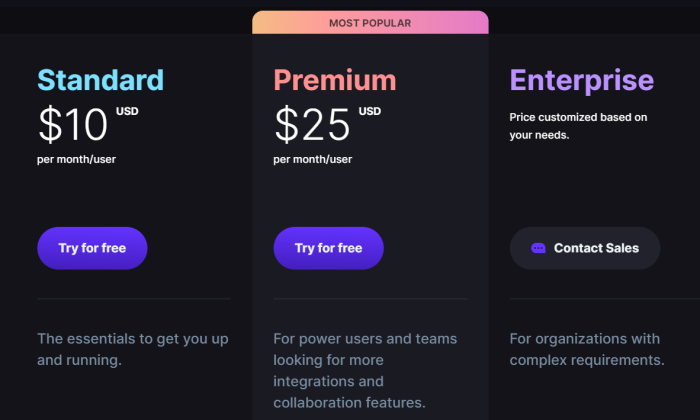
All OpenPhone plans are flat rate with 1,000 calling minutes and texts per month. It’s billed as “unlimited” but, like many providers, this is within the acceptable use policy, so I wouldn’t use this service to run drip campaigns or anything like that.
Standard includes most of the features I’ve described, including Slack, Zapier, Google Contacts and email integration. If you want the ability to transfer calls, a more complex IVR, or integration with HubSpot you’ll have to go with Premium.
Right now, HubSpot is the only CRM integration, but integrations with Salesforce and Pipedrive are in the works.
OpenPhone is a young company that’s constantly upgrading their service and adding critical features. I like where it’s going, but I already like where it is today more than any other lightweight business phone app.
Try OpenPhone free for the first week and never look back.
What I Looked at to Find the Best Business Phone Systems
All my top recommendations for business phone systems are cloud-based, which means you make calls through the internet instead of a landline. They’re also hosted, which means you sign into a service to use the system rather than build the infrastructure yourself.
For most companies in 2021, a cloud-based hosted phone system is going to be your best bet. Here’s why:
- Unlimited Calling: Say goodbye to per minute charges for calls or a set block of text messages each month. Every provider I’ve reviewed offers unlimited calling in the US and CA. You’ll also get unlimited texting and video conferencing, if that’s included in your plan. Where there are limits (or free calling in additional countries), I’ve called it out in the reviews.
- Lower IT responsibility: Your provider will host the phone system, so you have a lot less to worry about in terms of security, maintenance, and keeping the network up 24/7. If you host your own system, you have to buy all the equipment and manage the system yourself.
- Remote work ready: People can sign into the system securely wherever they have internet. If you host your own system, there are a ton of security issues that crop up when you have people trying to access your system from unknown or home networks.
- Cost: Running your phone system through the cloud is cheaper per month than using a landline. There’s also much less equipment to buy, which decreases your initial outlay for a new system—no PBXs, routers, switches, upkeep, or need to have additional wires to your location.
- More functionality and control: You get all the call handling features that you get from a traditional PBX—like call routing, conferencing, and voicemail—but these can all be managed by non-technical people. Admins and managers are going to be able to make changes to the phone system themselves, which was not always possible with older systems.
- Scalability: You can add new users without purchasing additional infrastructure. You can also upgrade plans to access new features without any sort of downtime or migration headaches.
- Future-ready: Nothing is truly future-proof, but cloud-based phone systems are definitely the direction that things are headed. Each year, these systems get less expensive and more powerful, whereas the traditional PBX/landline setup is becoming harder and harder to accommodate.
You can still make calls over landlines or host your own phone system on premises, but I don’t recommend it for most people.
Landlines make sense if there is no way to get fast internet to your business—but it’s not really a choice in that case.
In terms of hosting a system yourself, you 100 percent need IT staff to troubleshoot issues and keep it up 24/7. And even then, pulling your IT team away to resolve issues at all hours might end up being more expensive than getting the phone system you don’t have to think about.
Personally, I can’t imagine going back to a landline, trying to run my business off a second cell phone, or hiring a fleet of techs to manage my phone system for NP Digital. You couldn’t pay me.
But I’ve got marketing ventures and millions of readers in different continents—my communication challenges aren’t the same as everyone else. To help my readers, my team reached out to five experts from different quarters of the business phone system world to gather perspective for prospective buyers.
These conversations confirmed for me that cloud-based phones are the way to go, and I learned some really great ways to approach the different decisions that businesses face.
No one is using landlines any more, according to Matt, a backend IT veteran. Right now, he handles all the communications for a nonprofit healthcare provider that has several clinics spread across a major American metro area.
Every dollar counts for these clinics, so one of his first projects was helping them switch over to a cloud-based system. “With voice over IP, you can take your existing internet connection and basically slap a phone system on top of it,” he said. “It’s just like a layer,” rather than having to find someone familiar with wiring new cables to the office.
Nor are people managing their own phone system as much as they used to. I spoke with Nikhil, who helps small businesses install open-source phone systems that they can manage themselves. He noted that a lot of people who start out managing their own phone system wind up buying managed plans.
“It’s the support plus SLAs,” he said. Instead of hiring people, these companies decide to let someone else handle the backend.
“They don’t have to mess with the technology at all,” said Nikhil, “and they’re basically not seeing any downtime.”
Lawrence works for a VoIP (voice over internet protocol) provider that actually built their own network. He emphasized how you really need to know what you’re doing if you host your own system on premises.
For example, you’ll have to deploy the phone system behind a firewall, which regularly causes all sorts of trouble for cloud-phone systems, like one-way audio. “This can be fixed by configuring your firewall correctly,” said Lawrence, “but it can be difficult because most of the problems don’t occur all the time—it’s hard to reproduce issues.”
Every phone system is going to have things go wrong—with a managed plan, you’re not on the hook for solving these mysteries. As Lawrence said, people can stop worrying about the phone system and more about taking calls.
But of course it’s not just making calls any more. Guy talked with my team about the “big shift” in how customers are making contact with businesses. He started working in call centers more than 15 years ago. Now the contact centers he manages connect with customers through talk, text, chat, email, and social media.
Guy’s question for companies is, “Are you gathering demographics about your customer base, figuring out age-brackets and trends?”
You can do this easily with VoIP, which gives you a lot of ways to connect your communication data to reporting tools and other business software that lets you harness these insights. Doing this with a traditional phone system would be much more expensive, if it is possible at all.
Terry, who ran the IT backend of call centers rather than administration like Guy, emphasized how painful it is to switch from one phone system to another. “It’s worth your time to really weigh your options before making the switch and making sure that it’s not just enough.”
It’s probably a lot smarter to get more than you need today, or to find a system that will more likely accommodate future changes.
You definitely don’t want to find yourself “in a situation where you’re on a system that can’t handle what you need it to do from day to day,” Terry said. “Trying to find a quick fix to work around that is very hard.”
Running your business phone system on the internet is definitely the least risky, and likely least expensive way to go. But even among this particular type of business phone system, there are things you want to pay attention to.
Here’s how you decide from among the best options.
Requirements for Cloud-Based Phone Systems
Because you are calling over the internet instead of a landline, you have to make sure your network can handle it.
Now VoIP doesn’t require a ton of bandwidth on its own, but the connection has to be stable. Any delay or issues with the data being transferred and real-time voice/video communication becomes choppy.
You’ve probably had your internet bug out during a call. It really ruins a conversation, which is a death blow for sales, customer service, or really anyone using the phone system for business.
So what do you need?
It’s going to depend on how many people are using the phones (or other channels) and what else is happening on the system.
Nextiva lets you test your internet speed on their website. You can simulate up to 200 phones, and you’ll find out all the important metrics—upload speed, download speed, latency, jitter, and packet loss.
Ideally, you have (or can get) fiber internet as opposed to cable or DSL. The latter two “high-speed” internet options are fine for home users, but VoIP is simply not going to be reliable for business on DSL.
Cable is better, but you still could run into issues if you have a decent number of people making calls. “For one office it could work,” Matt said, “but if you have multiple offices, a cable modem is just not going to cut it.”
He had to convince the healthcare clinic he worked for to switch to fiber, which was over three times more expensive than the cable service they were using. Yes, it was going to cost more, but both customers and employees were reporting issues with the current service. Call quality was not great, and there were dropped calls from time to time.
These are important, timely conversations with patients. Matt and his team prioritized voice traffic on the network, which made sure that calls got as much bandwidth as possible, but it slowed down the internet for all the employees.
“It was ridiculously slow,” Matt said. Although it allowed the phones to work, “the internet traffic was much, much slower until we put the fiber in. Now we have no complaints.”
With fiber, the upload/download speeds are the same, whereas cable they’re different. You may have 100 down, 40 up. So, if people are uploading a lot of documents or using heavy-weight CRM software, trying to make calls over cable is going to get problematic. This is what happened to the company Matt worked with. Definitely something to avoid.
One other thing to pay attention to, according to Terry, is trying to run that CRM software plus a phone system on low-end computers.
“You can run into some issues for a computer that’s probably pretty good for browsing the web and doing basic stuff,” he said. But once you integrate the CRM, “all of a sudden it’s stretched to its limits.”
This can cause problems with connectivity and performance loss, “where you get an echoey call or other weird issues that are pretty hard to deal with.”
My advice is to address the requirements of any system head on, especially if you are integrating powerful software with your phones.
At some point, any savings from low-end equipment or cheap internet is going to start to blow back on you. “Just as people have factored in electricity or insurance, it’s a cost of doing business,” Terry said. “You have to have a strong internet backbone if you want to have that stability and uptime.”
Desk Phones, Headsets, and Softphone Apps
You’re going to hear that some of these business phone systems are “no hardware required.” Is that for real?
It’s true enough that cloud-based systems don’t require routers, switches, PBXs, or even desk phones—you just need the internet. With the options I chose, you can set people up with a softphone, which is just an application that allows people to make calls through your system from a tablet, mobile phone, or their computer with a headset.
A lot of people are using softphone apps these days, Nikhil said, because of the flexibility.
“It’s easier to just download the app and connect to the servers,” he said, talking about why cloud-based phone systems are so attractive to customers. Their powerful softphone apps offer “flexibility without the maintenance and troubleshooting.”
Still, you have to think about the environment where these phones will be used. As Terry pointed out, you can’t just get the cheapest headset for every user planning to use a softphone.
Investing in high-quality noise-cancelling microphones is really valuable if you have a bunch of sales folks making calls in the same room. Otherwise, “it’s harder to build trust with customers” who can hear the other conversations in the background.
For my part, when someone calls me from a number I don’t recognize and I can tell the speaker is sandwiched between a bunch of other folks blasting out calls, my reaction isn’t positive.
A little bit of extra money on some good noise cancelling headsets is definitely going to increase your conversion rate, whether you’re serving or selling to customers. RingCentral has a great selection of headsets that work really well with their system. So does Nextiva.
The other big advantage to softphone apps is that they are much easier to configure. For the most part, you are just signing in to access an account—so you can work from anywhere, and your number follows you around.
Desk phones, on the other hand, “create more headaches for me,” Matt explained. “As people move around, their extension follows the phone, not them.” When staff get shuffled around from one health clinic to another, Matt has to re-provision them on different servers.
For employees that just use the softphone app, it’s easier because they have a single extension, “and that extension follows them no matter what office they go to, because it only requires an internet connection.”
But some offices still want desk phones, retail stores need wall mounts, hotels have to have a phone in every room, and so on. If you are in the position of needing so-called “hard phones,” there are a few things to pay attention to.
“I would really look at something that supports open standards,” Lawrence said. If you go with phones from certain providers—like Cisco, for example—those phones are only going to work on a Cisco system.
On the other hand, Lawrence explained that open-standards phones, “can be used with most PBXs that exist, and you can easily switch from one provider to the other.” This is going to give you a lot more flexibility and control, not to mention being better positioned for an uncertain future.
The other big thing that Lawrence said buyers should pay attention to is the provisioning system. You want to make sure that the phone manufacturer offers a provisioning and redirection service that makes it simple to add new phones. “So if you have to configure hundreds or even thousands of phones, you can just plug them in, and they will work.”
Providers like Ooma can be a great choice for companies that still want phones. As people needed to work remotely, folks with Ooma office just took their desk phones and plugged them in at home. Everything worked fine—calls were still secure and all the routing features worked like people were still at the office.
For the most part, the providers I selected will let you keep using whatever phones you have. If you already have IP phones, great. If you have analog phones, most providers will sell you an adapter that will let them call through the internet.
In terms of manufacturers, the experts consistently cited Poly and Yealink for consistently delivering phones that have good voice quality, are easy to use, and work well with a lot of other technology. Poly (formerly Polycom) received especially good reviews from the experts as a source for conference phones.
As Matt said, “they just seem to have better microphones.” The standard base conference phones work pretty well for a small room, but you may want to get additional microphones for a room that’s large enough for 12 or more people.
If you still use fax machines, look for a provider that offers that specifically. Fax machines use a different modem than phones, so you can’t just layer it on top of VoIP. Providers like RingCentral and Ooma have all the adapters and capabilities you need for stress-free faxing.
In the end, cloud-based business phone systems require less hardware than traditional set ups—it’s no contest. But at the same time, you may need headsets, desk phones, and conference phones, and you want to get high-quality equipment.
Voice and Unified Communications
Other channels are gaining ground, but voice is still a critical component of business communications. “I just want to speak with an actual person,” is a feeling we’ve all had as customers. But it’s simply not enough to only have voice communications these days.
A lot of the solutions I like give you multiple channels with your service. OpenPhone and Grasshopper both give you texting with voice to connect with customers. RingCentral, Nextiva, Oooma, and Dialpad support other channels as well—like chat, video, fax, and email—which is why these providers are able to offer truly unified communications.
This is ideal for reps, service agents, and other employees because all of their communications are centralized in a single platform—no switching accounts, forgetting passwords, or losing track of conversations.
People simply aren’t using the phone as much as they used to—although it is still really important—and increasingly using other channels. As Lawrence noted, new research has shown that younger people are especially hesitant. “They’d much rather go to a website and click on a chat button than pick up the phone,” he said.
And it’s not just Millennials who appreciate other opportunities to connect with companies. Over 15 years, Guy watched the call centers he managed become contact centers. He’s noticed multiple age brackets interested in chat, text, and making contact through social media platforms. He said the latter is “definitely something that you want to look at when you’re upgrading, changing, or purchasing your business phone system.”
Every business is different, and Guy encouraged companies to use surveys and outbound campaigns to get feedback about how they’d like to make contact. “You have to know your customers’ tendencies and hone in on what they want to do.”
But it’s not just consumer preferences driving the shift towards unified communications. For the healthcare clinics Michael supports, the automatic texting feature is an important complement to phone service. He explained, “Once the appointment is made, we can then automatically text patients, reminding them of their appointment, as well as any future appointments.”
This ability to automate texting is an advantage to any business that books appointments, confirms orders, or wants to update customers about new offers.
Staying competitive is likely going to mean being available on more channels for your customers. “Make no mistake,” said Guy, “You want to open up other options in order to communicate.” It’s going to come at an added cost, but there wasn’t a person I talked to who thought that the phone alone was going to make companies fit for survival in the 21st century.
Now, what if you’re a company that just needs voice as a way to communicate internally? Or be generally reachable for things like deliveries and meetings? If that’s all you need, the benefit of the trend towards unified communications is that you can get a basic phone system for a steal.
OpenPhone and Grasshopper are limited to talk and text, but they are going to cost considerably less than unified communications products.
You can also go with basic plans from some of the other providers, which include excellent voice capabilities for a bargain. RingCentral and Nextiva are great for this, and if you ever want to add more channels, it’s as simple as upgrading your plan.
Integrating Phones With Your Business
A cloud-based phone system can integrate with your other business software. This is an opportunity you should absolutely take advantage of.
Many of the best hosted options include pre-built integrations with popular apps, calendars, CRMs, ERPs, and other tools. This is going to streamline employees’ daily workflows and make staying organized so much easier.
Within a CRM like Salesforce, for example, your employees will get click-to-dial capabilities. This saves so much time on every call. On top of that, all call recordings, notes, purchase histories, and so on are stored automatically with the customer account, which makes it much easier to track down info later.
Lawrence said that the CRM integration was far and away the most valuable aspect of their phone system for most customers.
“When a customer calls, you don’t just see a number,” he said, you see everything that’s in their CRM profile. “Who they are, what kind of services they subscribe to, when they last called, and what the call was about.”
Say there’s an ongoing issue and the customer has called five times. The agent picking up that call can see what’s happened already. The customer doesn’t have to re-explain themselves—which everyone hates doing.
It puts your customer at ease to know that the person they’re speaking with knows what’s going on, and the agent is on a much stronger footing to help.
That’s just the basics in terms of what CRM integration can do, and I haven’t even mentioned what’s possible with other business apps.
Chatbots can start conversations and gather information before switching the conversation over to a relevant agent. Integrating your phone system with your knowledge base software will automatically provide agents with the right script and information, or provide your customer a fast answer without an agent having to pick up the phone.
So there’s a lot you can do, but as a buyer, here’s what you should be thinking about.
Unless you have a team of developers, you are going to want to stick with the pre-built integrations from providers like RingCentral, Dialpad, and Nextiva.
Yes, some vendors offer an open API that lets you build out your own integrations, but getting these to work properly (and efficiently) is going to be a lot of trial and error.
This is something where you’d want to use a hosted phone system, Nikhil told us. He has a lot of experience helping companies build out their own phone systems. “With open source it’s kind of a black box,” he said, “so use a managed service provider if they want the integration.”
Finding a phone system that integrates with the tools you use is a critical consideration. But it’s not enough to just confirm that a vendor offers pre-built integrations.
“Some of them are easy and out of the box,” Terry said. But it’s not always the case. Sometimes, “you have to do a lot of complicated development work, or just jump through a lot of hoops to make systems communicate with each other the way you want.”
You really need to test the integration to see how it drives. But how many integrations are you going to demo? That’s a lot of work, time, and effort.
Terry said it’s definitely worth your time to reach out to your account rep and ask for a reference. If you use Zendesk, for example, ask your rep for the contact of another company that’s about the same size as yours and uses the service platform in a similar fashion.
“You can have a pretty candid conversation with someone in the exact same position that you’re in,” said Terry. “Generally they’re pretty real about what works and what doesn’t work.”
Securing Your Business Phone System
Security is one of the big reasons I’m such a fan of hosted business phone systems.
When you host the system yourself, you’re responsible for securing everything. This is hard enough if everyone is working in the same office, and much more difficult if people are working from home, multiple branches, or signing in from unprotected networks like coffee shops and hotels.
Why not go with a hosted solution? All of the providers I picked handle security so you don’t have to.
You don’t have to worry about provisioning the phones correctly, ensuring that calls are encrypted, and that your phone system is hardened to outside attacks.
I really agree with Lawrence, who said that one of the biggest questions you have to ask about any potential provider is, “Do they offer a secure connection for the phones that are connecting to that system?”
This is a must for me. Toll fraud is a serious issue. Nearly every expert I talked with highlighted the importance of security for business phone systems because each year, there are millions of dollars lost.
“There are always systems on the internet that are looking for vulnerable VoIP systems, and those are actively being abused,” said Lawrence. It’s happened to some of Lawrence’s clients, but fortunately his company has systems to detect and prevent that behavior. “Ideally what you want is a provider that has the phone system in their network, that can do the maintenance and security of that system,” he said.
This removes the responsibility of security from your plate. All you are on the hook for are the standard security considerations when doing anything online: using strong passwords, enabling two-factor authentication, de-provisioning old users, and so on
Because he’s doing the IT backend for a healthcare provider, Matt has to be ultra-conscious of security and privacy. A single HIPAA violation can cost thousands of dollars or even result in jail time.
But because Matt uses a secure business phone system, there is a lot less to worry about. “It’s impossible for someone to barge in on a call without somebody knowing what’s going on,” he said. “So there’s no concern of a HIPAA violation.”
For companies with compliance and security concerns, going with a hosted business phone system is going to give you the protection you need out of the box.
All communications that go through RingCentral, for instance, are protected by TLS and SRTP to prevent a bad actor from listening in. They also manage all the firewalls, session border controllers, fraud analytics, and systems hardening. It’s like you get enterprise-level security simply by signing into their service.
If you deploy on premises or host your own solution in the cloud, all the backend IT legwork is on you. “You’re responsible for securing that system,” Lawrence explained, “making sure that communications with the phones are secure, and that no outside actor is abusing your phone system for any kind of reason.”
Security is critical, and you will have a lot less to think about if your users are signing into a cloud-based system rather than trying to connect to a traditional on premises system.
Summary
To say you have lots of options to consider for a business phone system would be a drastic understatement.
But, by using this guide, you’ll be equipped to make the right decision based on your needs. Use the perspective from the experts I spoke with to round out your search and make sure you’ve considered every angle that’s going to impact the experience for your employees and customers.
By going with one of the above systems, you know you are getting a secure solution that’s built for the way the world works today. There’s no equipment to purchase, and all but the lightest options will work fine with your existing infrastructure.
In a market that’s saturated with phone systems for businesses, I really like the seven options I reviewed:
- Nextiva — Best for remote teams
- RingCentral — Best for integrating phones with your business
- Ooma — Best for companies that want deskphones
- Grasshopper — Best for businesses that need fewer than 10 lines
- Dialpad — The only way to deploy a contact center in 10 minutes
- OpenPhone — Best for single teams and sole proprietors
So start your search there, and use the buying guide I outlined. This will steer you in the right direction.

